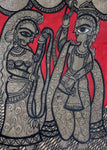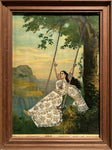A Love Affair with Tribal Carpets - In Conversation with Danny Mehra
Love comes in all shapes and sizes, and in the case of Danny Mehra, this couldn’t be truer. Danny got his first tribal carpet as a wedding gift from his mother-in-law. That’s when a whole new love story took form in Danny’s life. This was in 1983. Back then, he had two coveted tribal carpets as a gift. From thereon, 2 carpets became 4, 4 became 8 and soon the collection moved to two-digits, three digits, and more. “Today, my collection is large enough to cover a football field. Well, it’s proverbial of course. But, I am happy with how this collection has grown over the years,” quips Danny.
But, as all love stories, this journey also went through its phases. Danny had to wait for a while before he could start investing in tribal carpets. “I didn’t have enough money.” But, since the day he was introduced to this piece of artwork, Danny kept up with his pursuit of collecting and learning more about this unique art form.
Today, Danny jokingly says, “This is my mid-life obsession. Tribal carpets are my sports cars. So, while some may invest in a red Ferrari, I’ll invest in the most funky and distinctive tribal carpet.”
 (Carpet from Danny's Private Collection)
(Carpet from Danny's Private Collection)
For the uninitiated, tribal carpets are typically made by nomadic and semi-nomadic tribes. They are different from the regular floral themed carpets. Their designs are naïve, raw and abstract. Largely, women weave these carpets, and they don’t really have a set design in mind. Every tribal carpet has a unique story that comes from weaver’s thoughts and expressions. Elements like flowers, plants, human beings, birds, and animals such as dogs, sheep and camels give base to the story line.
“Tribal weavers lived a very nomadic life. They moved with their herd from one pasture to the other. This spirit of being a vagabond is seen in these carpets. And, that’s what makes them so unique,” says Danny.
At present, Danny owns carpets from various parts of the world, including Iran, Turkey, Armenia, Azerbaijan, Georgia, Dagestan, Uzbekistan, Kyrgyzstan and Turkmenistan. “I am completely fascinated by the perfect imperfections of these carpets. The designs are spontaneous, and they often break the rules. It’s the stories and personal expressions of the weavers, straight from the heart, that make these carpets so strikingly beautiful,” says Danny. He adds, “Every time I look at a tribal carpet, I find something new in there. This is also true for carpets I’ve had for years in my own collection.”
Sharing his knowledge further, Danny says, “The women wove the carpets one row at a time, starting from the bottom and then moving upwards. There was never a defined limit to the height of the carpet, it was usually based on the composition. And, over the course of weaving, women improvised on the length and design. Hence, in some carpets, at places one can see different knots and variety in the border, narrower on one side than the other. This creates very interesting design nuances.”
 (Variety of tribal carpets showing different nuances and unique characteristics)
(Variety of tribal carpets showing different nuances and unique characteristics)
In olden times, the women weavers didn’t follow a theme; their hands just wove a story. Hence, there was always one theme per carpet, and no replicas. “But, this is slowly changing. Newer tribal carpets are often based on a design, and they are more static in nature. Their designs are well formed. The natural colours, too, are now making way for the chemical ones,” rues Danny.
However, undeterred, Danny is still relentlessly looking for rare carpets and building his collection. “I try and look for something that’s different. It can be anything from colours to patterns. For me, a carpet is like art, and its’ essence will always remain true.”
Talking further, Danny has a suggestion for new collectors, “Don’t get carried away by the confusing jargon or terminology. It’s more for trade. Instead, look for rarity of composition, the condition of the carpet, its age, colours, the dyes that are used and the overall quality of wool,” suggests Danny.
“Carpets, as an art form, is highly undervalued. Perhaps because weavers don’t brand the carpet or leave signatures on their work of art,” Danny points out. And statistics highlight this stark reality; the most expensive carpet ever sold was at $33.8 million at a Sotheby’s sale in New York in 2013, while quite recently, a Pablo Picasso masterpiece made history after being sold at an auction for $179 million.
So unlike paintings, carpets may or may not appreciate so much in value, but they most certainly will add a new dimension to your home. Interestingly, even though most people view carpets as floor art, they can, in fact, be used to decorate walls as well.
On a parting note, Danny says, “20 years ago, I thought I knew everything about carpets. But, today, I think I know very little. In fact, the more I learn, the less I know.” Even though tribal carpets have been heavily researched, there is still a long way to go. For collectors like Danny, this is what continues to add mystery, magic and romance to the lure of old tribal carpets.
 (Danny Mehra at his residence with part of his carpet collection)
(Danny Mehra at his residence with part of his carpet collection)
Danny Mehra grew up in India. During the course of his post-graduate studies and corporate career, he had the opportunity to live and work in various parts of the world, which is where his tribal carpet collection was gradually built over time. Several pieces from Danny’s collection have been published and exhibited in the US, Europe and India. Danny, his wife Renuka, and their two adorable dogs (Luri and Tulu) currently live in India. Both dogs are named after tribal carpets.






















































































